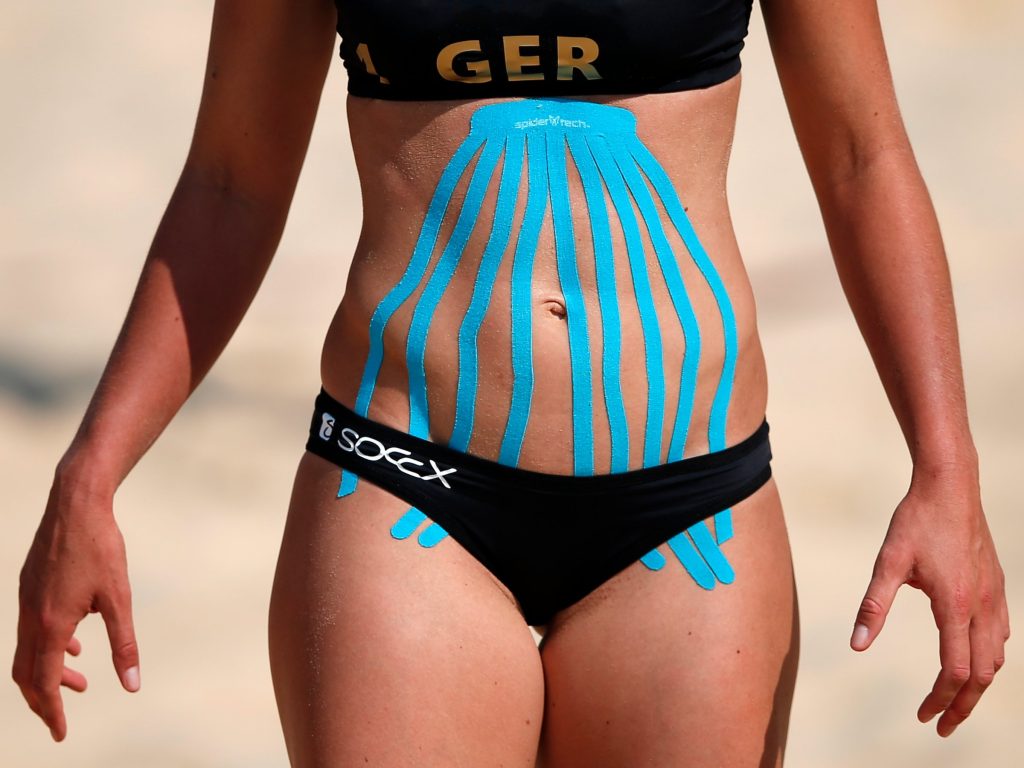Maybe Paraguayan javelin thrower Leryn Franco was just dealing with a sore shoulder that day?
Nothing screams beach volleyball quite like bright strips of colorful tape running across your arms, legs, and shoulders.
With the 2016 Summer Olympics kicking off, there’s plenty to get excited about, from incredible athletic performances to how Rio manages the flood of athletes and fans.
And if the 2008 and 2012 Games are any indication, you’ll definitely see athletes wearing bright strips of kinesiology tape, also known as kinesio tape, across their bodies.
But what is it? And why is it there?

Maybe Germany’s Katrin Holtwick felt a boost in her range of motion from this. Just maybe.
Several versions of this bright adhesive exist. In 2008 and 2012, athletes often wore Kinesio Tex Tape, created by a Japanese chiropractor in 1979. Today, KT Tape is the official kinesiology tape licensee for Team USA.
Kinesio says their tape works by gently lifting the skin, which helps ease discomfort and supports lymphatic drainage. You can place it over sore or tired muscles to help calm inflammation and reduce pain—kind of like giving your body a little extra backup when it needs it.
KT Tape says their tape gives your body a light, flexible layer of support so you can stay active—even while healing from injuries. It also helps your brain and muscles stay in sync by creating something called proprioception, which is just a fancy way of saying it helps your muscles fire more effectively—or chill out—depending on what your body needs.
Both sites list a wide range of conditions the tape might help with, from headaches and sore muscles to shin splints. But there isn’t much solid research to fully support all those claims.
Does it Work?
Many athletes use athletic tape now and then for support or to restrict movement, but what makes kinesio taping stand out? Is there really something special about it?
It’s kind of hard to say. Most research hasn’t found significant benefits to using the tape.
Some reviews of studies looking into how kinesio taping works for people with muscle and joint issues. But didn’t find solid proof that it actually helps. So, while some folks swear by it, the science hasn’t fully backed it up yet. So for people with chronic conditions that need treatment(not usually Olympic athletes), the tape probably doesn’t do much.
One recent review in the British Journal of Sports Medicine found that kinesio taping works better than doing nothing at all when it comes to pain relief. Other studies suggest it might also help improve range of motion and muscle activation. From range of motion slightly, but there’s not necessarily evidence that one type of tape is better than another.
Kinesio Tex Tape may offer slight relief in pain or range of motion, but the effect is minimal. As for Latvia’s Edzus Treimanis and his face tape on the BMX bike — if it feels good, ride on, buddy.
Still, many athletes swear by it. Beyond Olympians, stars like Lance Armstrong and David Beckham also used the tape during their careers.
Surprisingly, that choice may be more logical than it seems, even if there’s no actual physical benefit to taping.
If the tape offers even slight pain relief or better range of motion, it matters to Olympic athletes. A tiny boost—just 0.05%—can mean the difference between winning a medal or missing the podium.
Final Thoughts on KT Tape
Even without a real performance boost, the tape might still help if the athlete believes in it. The placebo effect is powerful as studies show people feel less pain. Also they feel less fatigue when they think they’ve taken something like caffeine or morphine, even if it’s just a sugar pill.
Human physiology professor Steve Harridge told Reuters in 2012, “If athletes think it helps, that belief alone can give them a psychological boost.”
A mental boost and added confidence might be all an athlete needs to throw the javelin farther.
Also Read:
- Cristiano Ronaldo Close To Sign Deal With English Premier League Giants Manchester City
- Novak Djokovic disqualified from US Open in 2020

